|
[For the
uninitiated, a 'blog' (or weblog)
is a web journal with links. This gives me a chance to add short, 'off the record' style items that
wouldn't merit a separate article. I try my best to keep entries informal,
frequent, brief and (hopefully) interesting. For more information
about Jamie Goode, see the about the author
section. ]
Saturday
6th August 2005
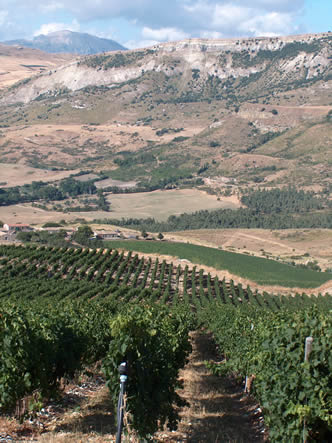 Feeling
a bit sluggish today, but nothing to do with grog. Rather, my state of
suboptimal mental function is caused by tiredness, brought on by a
hideous journey home from my Sicily trip. Getting into Stansted at
11.15 pm, we were delayed at passport control by half an hour, and
then I had to take a bus to Heathrow, followed by a night bus to
Feltham. Could have been a lot worse, I guess, so I'm not complaining. Feeling
a bit sluggish today, but nothing to do with grog. Rather, my state of
suboptimal mental function is caused by tiredness, brought on by a
hideous journey home from my Sicily trip. Getting into Stansted at
11.15 pm, we were delayed at passport control by half an hour, and
then I had to take a bus to Heathrow, followed by a night bus to
Feltham. Could have been a lot worse, I guess, so I'm not complaining.
The
Sicily trip was very good. Calatrasi are a forward thinking outfit,
making some of Sicily's best wines. They have a kiwi winemaker (Tamra
Washington) and an Aussie viticulturalist (Sean Howe), who are good
people, and made sure we were well entertained. They wanted an honest
opinion of where their wines fitted in the marketplace, so they
arranged a blind tasting of Nero d'Avola with their competitors. It's
a really good idea, and I'll produce an article on this soon.
Dinner
in Palermo on Thursday night was fun. It wasn't until about 2 am that
we found ourselves back at our accommodation. A leisurely start
yesterday was welcomed, and the tasting followed, with three flights
of Nero at different price brackets. After the tasting we had a long
lunch, followed by a trip to see vineyards. In this case, a
spectacular 70 ha vineyard at around 700 metres on limestone-based
soils (above right). Stunning. Time for a quick beer in
Corleone, before making our way back to Palermo and the delights of a
3 hour flight on Ryan Air.
Wednesday
3rd August
Nipped in to Bordeaux Index yesterday for a tasting of
two wines from Domaine Matassa. This is one
of the rising stars of the Roussillon
(it looks like Bordeaux Index may be representing them in the UK). The
2004 Blanc is utterly fantastic, with a long life ahead of it;
in contrast the 2003 Rouge Cuvťe Romanissa was a little
overshadowed: nice, earthy and spicy but perhaps just lacking a little
presence. Also there was Neal Martin of the excellent www.wine-journal.com.
I first tasted the Matassa 2002 (inagural vintage) a year or so
back, and this is a producer Iím predicting a bright future for. I
always have a slight tinge of sadness on catching producers like these
early on, because thereís every likelihood that five years later I
wonít be able to afford them as the rest of the world realizes just
how good they are. Unless, of course, I get rich. I have no particular
desire for riches, with the exception that being loaded would enable
me to buy Ė and drink Ė serious wines. Not for the reason of
conspicuous consumption, but simply because Iím passionate about
wine and I have an insatiable curiosity for trying, and attempting to
understand, a wide range of great wines.
In partnership with David Thomas of the Cellar
Door in Overton, Bordeaux Index also represent many of the Barossa
rising stars I wrote about earlier in the year. I tried one of these
wines last night: Kym Teusnerís 2004 Joshua. This unoaked
Grenache/Shiraz/MourvŤdre is really singing at the moment, showing
vivid, perfumed red fruits backed up with a spicy structure. Tonight,
Iím drinking another David Thomas/Bordeaux Index wine, the Mount
Billy Antiquity Shiraz 2001 Barossa Valley. Itís another fantastic
wine: dark, concentrated and spicy with some tarry, herby notes that
suggest this has seen some American oak. But it works with this wine
Ė I guess itís a more traditional Barossa style than some of the
new Barossa wines, but itís up there with the best of them. My only
slight criticism is the combination of the oak and acid, which gives a
slightly bitter, green-ish sort of finish. Maybe Iím just being
ultra critical Ė itís still a lovely wine.
Itís all very circular: tomorrow Iím off to Sicily,
with Sam Harrop MW (whoís one of the partners in Matassa). Weíre
going to Calatrasi, to help see how their wines stack up in the market
place, by means of blind tasting against the competition. It will be
fun, Iím sure.
Saturday
30th July
Had
lunch at Corney & Barrow yesterday, after a small tasting,
together with Guardian journo Simon
Hoggart, who does the wine offer
for the Spectator. C&B do things in style. The lunch was very good
indeed, prepared by resident chef Colin, who in appearance and
demenour reminded me a bit (only a bit) of the character Colin from
the Brittas Empire. As you might expect, we drank some wine. We
started off with a Domaine Leflaive Puligny Montrachet Les Pucelles
1990. It was a surprisingly dark orange colour and I saw Adam
Brett-Smith's eybrows raise. Oxidised. So we had a second bottle,
which was much better, showing some evolution but also impeccable
balance. Next up, a blind red - FranÁois Mitjavile's 1993 Terte Roteboeuf,
a cult St Emilion from a small (by Bordeaux standards) vineyard of
5.7 hectares. Dense, tight, savoury and very good indeed.
The final wine was a hard one to spot blind. It was ripe, seductive
and elegant - not quite a Burgundy, because of the overt ripeness, but
definitely in a Burgundian sort of style, and very classy. It was the
Tenuta
di Trinoro 'La Cupole di Trinoro' 2000.
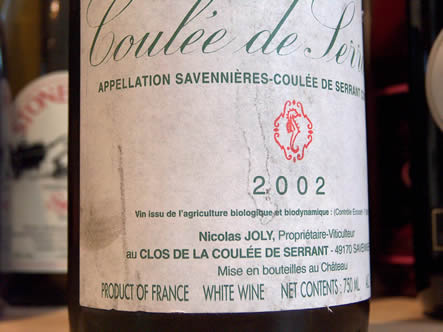 Two
interesting wines for Friday night drinking. Nicolas
Joly's Clos de la Coulťe de Serrant 2002 is a unique wine.
The fascinating thing about it is that it reveals itself to you a bit
at a time, shifting and evolving in the glass moment to moment. It's
also a bit of a weird wine: you have to work to 'get it'.
The nose is sweet and savoury at the same time, with complex notes of
pears, herbs and the Chenin damp straw. The palate is complex and
intense with an unusual texture: a little soft and flat in the middle
but then there's a big acid kick. Amazing length and real separation
of flavours: a multidimensional wine, ending in a spicy acidity. Then
the Moris Farms Avvoltore 2003 from Tuscany's Maremma region.
This is a big wine. Dark, spicy and intense with lots of tannins, but
these tannins are soft and ripe. Fantastic fruit, yet avoids being
overblown and too new-worldy. Another remarkable wine, but probably a
lot more accessible than the Coulťe de Serrant. Two
interesting wines for Friday night drinking. Nicolas
Joly's Clos de la Coulťe de Serrant 2002 is a unique wine.
The fascinating thing about it is that it reveals itself to you a bit
at a time, shifting and evolving in the glass moment to moment. It's
also a bit of a weird wine: you have to work to 'get it'.
The nose is sweet and savoury at the same time, with complex notes of
pears, herbs and the Chenin damp straw. The palate is complex and
intense with an unusual texture: a little soft and flat in the middle
but then there's a big acid kick. Amazing length and real separation
of flavours: a multidimensional wine, ending in a spicy acidity. Then
the Moris Farms Avvoltore 2003 from Tuscany's Maremma region.
This is a big wine. Dark, spicy and intense with lots of tannins, but
these tannins are soft and ripe. Fantastic fruit, yet avoids being
overblown and too new-worldy. Another remarkable wine, but probably a
lot more accessible than the Coulťe de Serrant.
Thursday
28th July
Iím enjoying doing the Sunday Express column. Itís fun. Part of my
brief is to use the food theme of the week in order to select wines
that (sort of) match. Iíve just been given my latest set of themes,
and on 11th September it is Ďbreakfastí. How fantastic. Wines with
breakfast! I think it was Yixin Ong who used to post to wine bulletin
boards about breakfast wines. So Iíll have to consult him on his
favourite combinations. With scrambled eggs, a nice crisp new world
fizz; with bacon butties, a toasty Chardonnay or Pinot Gris; with
marmalade on toast, a nice botrytised sweet wine. There are endless
possibilities. [For the record, I can't recall ever drinking at
breakfast time.]
With the Express gig,
weíve had a huge rise in the number of samples landing on the
doostop chez Goode. I used to be able to drink my samples; now I
canít. Most nights Iíll open a few different wines for tasting.
Itís interesting to group the samples together in mini-tasting
flights and do some comparing. The big danger, however, is for me to
become too reliant on samples and tastings, which could cause me to
stop buying wine altogether. Itís not that thereís anything wrong
with samples; rather, the problem is that you end up focusing on a
skewed population of winesóthose that people are most anxious to
flog. I have been buying wine still, most recently a case of Gros
Nore Bandol Rouge 2000 at £129 all in from Grand Cru Wines (a
snip: just over a tenner a bottle for this serious MourvŤdre-based
wine that will go the distance). I bought six of the 1999 vintage of
this wine and still have one left: of course, it should be the other
way round with an ageworthy wine like this.
Monday
25th July
Non-wine
related, I know, but I wanted to mention on this blog the passing of Richard
Doll, who died over the weekend at the grand old age of 92. One of
the worldís leading epidemiologists, Doll is responsible for saving
millions of lives. Why? He was responsible for demonstrating the link
between smoking and lung cancer back in the 1950s. This is something
we all take for granted now, but his achievement needs to be seen in
context: at the time of the study, most people in the UK smoked,
including 80% of adult males.
Dollís studies first highlighted the link between smoking and lung
cancer, and then proved it was causal. His later work showed that
smoking was also related to many other diseases. Good science,
communicated well to the public, has thus resulted in a sharp decrease in
smoking trends in the UK over the last few decades, literally saving
millions of lives. In other European countries where the message has
been less well communicated, and there hasnít been a corresponding
reduction in smoking, the mortality statistics are still on an upward
trend. Interestingly, I noticed that Doll was born in Hampton (in
1912), just a couple of miles from where I live. I never met him, but
he wrote a letter following the publication of a book I edited on
Alcohol and cardiovascular diseases, expressing some surprise at the
rather ambivalent summing-up by the chair, which didn't reflect the
positive tone of the discussions contained within. Indeed, Doll's
research encompassed the supposed health benefits of drinking (see this
paper, for example), and one of his last papers, published earlier
this year, was on this very topic.
see
also: Observer
profile on Sir Richard Doll
Sunday
24th July
Just a brief entry today. I'm still tired from Friday night. We
had some friends over, with their kids, who then stayed for a
'sleepover' to celebrate one of our son's birthday. So we had six
kids, aged under nine. Hell on earth. They went to sleep, finally just
after 1 am, and woke before 6.30 am.
Had
a nice wine last night. The Alovini Alglianico del Vulture 2000
is a lovely dense, rich modern-styled Italian red with good
concentration and an earthy, spicy structure. It's not too modern,
though. A nice balance between rich fruit and savoury structure. Great
balance. It's a sample from new venture Divinowines (so new their
website isn't up yet, so I can't link to it) and retails at £16. This
reminds me that I must drink more Italian wine. Today we're off to
Thorpe Park with the kids. The hell continues!
Tuesday
19th July
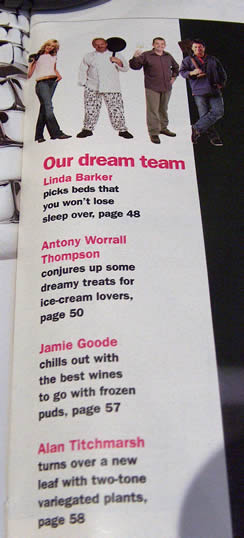 My
second Sunday Express column is out, and I've already taken some stick
for it. I got a phone call yesterday from a PR person who I thought
would have been delighted that I'd mentioned one of her wines in my
column. But she was furious (or was it upset, about to break down in
tears? I couldn't tell). It's because I mentioned that the wine had a
faint whiff of paint thinners about it. I guess this isn't terribly
flattering, and looking at it from her perspective, I see she's got a
point. But at the same time, I have to remember who I am writing for:
it's the readers that count. Sometimes winewriters get too close to
the trade and forget whose side they are on. I write to keep my
readers happy, and by doing this, the editors who commission me. You
can't be too worried if you upset the trade from time to time: it's
going to happen. No hard feelings. My
second Sunday Express column is out, and I've already taken some stick
for it. I got a phone call yesterday from a PR person who I thought
would have been delighted that I'd mentioned one of her wines in my
column. But she was furious (or was it upset, about to break down in
tears? I couldn't tell). It's because I mentioned that the wine had a
faint whiff of paint thinners about it. I guess this isn't terribly
flattering, and looking at it from her perspective, I see she's got a
point. But at the same time, I have to remember who I am writing for:
it's the readers that count. Sometimes winewriters get too close to
the trade and forget whose side they are on. I write to keep my
readers happy, and by doing this, the editors who commission me. You
can't be too worried if you upset the trade from time to time: it's
going to happen. No hard feelings.
[Football
talk] Couldn't let the leaving of Shaun Wright-Phillips pass without a
mention. It's sad, but inevitable. I've enjoyed watching him over the
last few years develop into the near-genius he is today. City never used to
be a selling club, but with Chelsea's riches, all clubs are now
selling clubs. £21m is good business, I guess, but it's a bit
dispiriting to watch the way Chelsea are currently buying up so many
good players just because they can afford it. One of my playstation
games is LMA manager: you get to buy and sell players and build a team
by skill and careful balancing of finances. There's a cheat where you
can have unlimited finances but I've never been remotely tempted to
use it because it removes any element of skill the game posseses. But
this is exactly what Chelsea seem to be doing. Football is only a
game, but the financial side has narrowly avoided taking the fun out
of it in the past. Now it seems this uneasy balance is faltering and
big money has the upper hand. I mean, if you were to hatch a dastardly
plan to ruin football as we know it, how would you do it? Chelsea's
current behaviour takes some beating as a strategy.
Sunday
17th July
Man, this weather rocks! The UK has been like Spain for
as long as I can remember. With the change in weather comes a change
in drinking patterns: crisp unoaked whites and well-chilled rosťs are
the order of the day (plus, of course, ice-cold beer). Generally, we
winewriters underestimate the affect that situation has on drinking
pleasure. We think itís all about the properties of the wine: it
isnít. The circumstances and our own internal state at the time have
a lot to do with the drinking experience.
Cricket on Friday (see entry below) was very
enjoyable. The Wine Trade XI was a strong one, and we only lost
because we declared earlier than we might on 224 for 6: they
overhauled our total in the last over of the game.
Wine of the day, with Sunday lunch in the garden, was Quinta
da Simaens Vinho Verde 2004. Itís light, zippy and  refreshing
with just a touch of carbon dioxide fizziness on opening. Not too
heavy, and perfect well chilled. refreshing
with just a touch of carbon dioxide fizziness on opening. Not too
heavy, and perfect well chilled.
Weíre currently trying to round up the rabbits.
Itís nice to give them freedom of our generously sized garden, but
itís hard work catching them afterwards. Youíve got to be quick.
Very quick. Last night after an extended chase one of them had a
squeaky kind of wheeze. I thought it was going to conk out. Happily,
itís still very much alive and resisting capture this evening. We
did try to name the rabbits when we got them, but itís impossible to
tell them apart. So thereís no point.
Friday 15th July
Had a fantastic day yesterday (Thursday), most of which was spent
at Hampton Open Air pool. It was hot, sunny and the water was at a
perfect temperature. Fiona and I picknicked, washing our food down
with some a quarter bottle of wine each. Mine was a cheap Kumala red
with some Pinotage in it Ė it tasted pretty good, but then just
about anything would in that setting. In the evening we popped into
Twickenham for dinner at the A bar, tucked away in a residential
street behind the Green. It has a wonderful courtyard so we ate
outside. Food is pretty good, winelist more than servicable. Itís a
little on the pricey side, but probably worth it.
This morning has so far been a disaster. Did you ever
see the John Cleese film Clockwise? Well, Iím living that experience
at the moment. My destination is Colchester to play for the Wine Trade
XI in a cricket game. The first leg of the journey was OK, but we hit
trouble when we were stuck on a hot Central Line train in a tunnel for
30 minutes.
So I get to Liverpool Street with time running out. I
join a queue for tickets, and the person in front takes 10 minutes
over their transaction (it was supposed to be a Travel Today window).
I present my railcard to the guy behind the screen and asked for a
boundary zone 6 to Colchester ticket. He gives me a lecture on how my
railcard is hard to read and I should get it replaced with a fresh one
but Iíll need to show proof of purchase, where did I get it from?
etc. etc. Iím getting a bit frustrated.
He wonít stop going on about how my railcard is hard
to read. I ask jobsworth, in the interests of time, to forget about
the boundary zone 6 bit and just give me a ticket to Colchester
because I am in a hurry. Not comprehending that Iím in enough of a
rush to skip the railcard conversation and take the £5 hit that comes
from not using it, he says again that he canít read my railcard.
This is where I make my big mistake. ĎJust give me a [expletive
deleted] ticket to Colchester,í I say, ashamedly unable to control
my staggering sense of frustration. Immediately he switches into an
affronted Ďdonít use that language with meí speech. I apologise.
He lectures me and informs me Iíll have to go to
another window and join one of the snaking queues and wait my turn
again. I apologise really hard, and eventually he serves me Ė I
leave with the impression he rather enjoys the sense of power that
this sort of interaction with customers in a hurry brings. Iím
usually a calm person; for me to stoop to the level of letting my
frustration show ptells me that I must chill a bit. Itís a symptom
of something inside, and I need to pay attention to it.
Now Iím on the train to Colchester and it looks like
Iíll just be in time. Letís hope the cricket is better than the
journey. We have to bring two bottles of wine as a match fee, to drink
at lunchhtime with the opposition. Iíve bought some Northern RhŰne
Syrah, the Mouton 2000 Vin de Pays des Collines Rhodaniennes and the
1996 Jaboulet Thalabert Crozes Hermitages.
Wednesday
13th July
Man, itís hot. Itís two showers a day weather (we're
talking personal hygeine, not precipitation), and it has been all
week. Not that Iím complaining: thereís nowhere quite as beautiful
as the UK on a hot summerís day. Well, actually there are dozens of
places much more beautiful; the point Iím trying to make is that
places that are normally cold and wet (such as England, Wales and
Scotland) have a charm of their own on a hot summerís day. The
trees, in particular, look wonderful.
So far, after a very late start, this summer is shaping
up a bit like 2003. Weíve had two sustained hot spells and the grass
on Twickenham Green (where my eldest had is sports day today) is a
whitish yellow; the soil compact and hard. But the vines on my
allotment are thriving: after the late frost which took out a good
proportion of the first shoots in late April, growth has been strong
but not too vigorous. The consequence of the frost is that fruit set
has suffered so the crop will be very small and a little late. The
quality should be excellent if we have a half-decent late summer.
Even though we are enjoying the somewhat atypical
weather, it raises the spectre of global
warming. If you are a reader from the USA I must apologise here.
As a rule, Americansóeven intelligent, well read, scientifically
literate onesódonít believe in global warming. Or should I say
more precisely, they accept the reality of recent climate change; they
fail to believe that it is significant, or that its origins are
anthropogenic (caused by human activity, most significantly greenhouse
gas emissions). So my mentioning of global warming will seem rather
preachy and misinformed to Americans; I apologise once more for this.
It's
hard not to be worried by the evidence, no matter how hard it is to be
sure of the predictions scientists make about future climate
change. The outlook for fine wine is bad: sites where grape varieties
are currently well matched to local conditions will suffer twofold
loss. First, the varieties will no longer be optimal for the site;
second, the increased unpredictability of climate patterns will play
havoc with vintage variation. There'll be many losers and few winners.
Monday
11th July
I enjoy getting my non-wine-geek chums to taste a couple of very
different wines, to see how they respond. Had two couples round
yesterday for a delightful long lunch, during which I served a couple
of contrasting reds. First, Domaine du Baruel's 1996 Cuvťe
Fontenilles, a Languedoc Syrah. The Baruel wines were only made
during the 1990s - 1989 was the first vintage by Rainer Pfefferkorn,
1998 the last before he sold up. They have proved remarkably long
lived, and the 1996 is still tight and quite youthful. It's an
intensely savoury, earthy wine that I like a lot. Distinctly old
world. I served it alongside the 2003 Clos de la Siete, Michel
Rolland's Argentinean wine, which is voluptuous, lush and ripe with
sweet blackcurranty fruit and a whopping 14.5% alcohol. The latter is
the obvious crowd pleaser, but both wines were appreciated, and one of
my chums even commented on the earthiness of the Baruel, which he
found positive. My preference? Wine is largely about context, and in
the context of al fresco dining on a warm summer's day, I think the
Baruel wins hands down. In fact, at the table, I can't think of a
context where I'd prefer the sweetly fruited Clos de la Siete: that's
more of a showy wine to sip on its own. I also wonder whether the
Siete might be a bit better with just a touch less alcohol.
| On
Saturday night Fiona and I went to a fabulous 40th birthday
party, held at out kids' school. We had to dress up in school
uniform, which was slightly bizarre, but enjoyable. Some of the
women took it a little bit too far, but I thought Fiona looked
fantastic wearing our oldest son's school uniform and with some
false pigtails and mutant teeth. Hmmm, nice. |
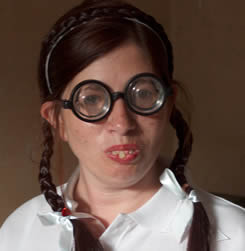 |
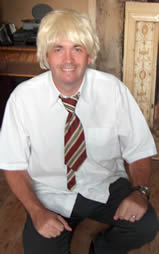 |
Friday
8th July
Still shocked by yesterday's events in central London; at this
time it seems a bit trivial to be talking about wine. I left the tube
at Regent's Park station around 9.20 am yesterday; we were hurried
out, and it was clear that something wasn't quite right. It was a
nervous day in town as it became clear what had happened. Wandering
back to Waterloo station late afternoon, I was surprised by how few
cars were on the roads and how many people were walking. The
atmosphere wasn't one of fear, but of quiet determination to carry on.
Reflected
on the day's sad, terrible events with a glass of Quinta da Casa
Amarela Reserva 2003, a little known but excellent Douro wine made by
Susana Esteban, winemaker at Quinta do Crasto. I like it more than the
Crasto wines: it has a lovely freshness of fruit and firm but elegant
structure (from both the tannins and the acids). Enjoyed with an
excellent Manchego cheese, which is becoming (along with Grana Padano
and Comte) one of my favourites.
Monday
4th July
Just back from a weekend spent in Chester, at the wedding of
cousin Ingrid. Now weddings can be (and frequently are) a bit of a
test of the guests' patience, but this was a really good one, and
Ingrid and John had clearly put a good deal of thought into how to
make it a pleasurable day for everyone. We were staying at the
racecourse, and the logistics were just perfect: it was a nice wander
through the centre of town to the church, and then the reception was
held within a couple of hundred yards of the hotel. Our kids were
entertained by professional nannies so they were happy, and before we
sat down to eat there was a nice twist - we had a fun session with the
drumcafe, where everyone was given a djembe drum and we spent an hour
beating out rhythm. Sounds odd, but it was very well done, and it
beats standing round for an hour waiting for the photos to be taken.
What about the wines? The wines? They were good, too. Lindauer fizz,
followed by Montana Sauvignon Blanc 2004 and Oyster Bay Merlot 2003.
The Montana is a brilliantly balanced, textbook Sauvignon with some
class. The Oyster Bay is very tasty, with a chocolatey richness to the
spicy fruit. Both wines are accessible without being bland, and are
versatile enough to work well with a range of foods. Tasting the
Lindauer, it makes me wonder why people bother with cheap Champagne.
It's fruity, rounded and balanced with a hint of smoky complexity
underneath the slightly herby fruit. Champagne is odd: you could have
spent a fortune serving Dom Perignon of Krug Grande Cuvee (both at
around £70 per bottle) in a similar environment, and I'll bet only
about two or three people there at most would have noticed the
difference in the absence of seeing the label. Narrowly missed out on
the sweepstake for the speeches (I guessed 36 minutes and it was a
refreshingly brief 33), and finished the dinner with a couple of
glasses of Dow's 10 year old tawny (nice) which brother in law
Beavington had smuggled in.
Saturday
2nd July
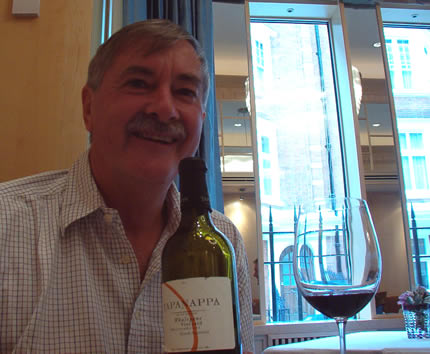 Brian Croser is one of the giants of the Australian wine industry.
He taught at Wagga in the 1970s and with his technical background was
responsible for the application of a lot of good science in the
vineyard and winery that has helped shape the modern Australian wine
industry. With his own winery, Petaluma, Croser achieved great
success: the Adelaide Hills Chardonnay (Croser was the first to plant
in this region, which is now a sizeable one with thousands of hectares
under vine), Coonawarra red and Clare Valley Riesling are all
benchmarks of their respective vineyard areas. The ride has not been
so smooth of late, though. Four years ago Petaluma was bought out by
the Lion Nathan wine group, and while Croser is still very much
involved (and proud of the wines), this move has clearly caused him a
lot of grief. His latest venture is Tapanappa, a premium red wine from
the Wrattonbully area (near Coonawarra in South Australia), and this
was the reason I met with him and PR dude David Lindsay for lunch at
the Capital Hotel on Friday. Brian Croser is one of the giants of the Australian wine industry.
He taught at Wagga in the 1970s and with his technical background was
responsible for the application of a lot of good science in the
vineyard and winery that has helped shape the modern Australian wine
industry. With his own winery, Petaluma, Croser achieved great
success: the Adelaide Hills Chardonnay (Croser was the first to plant
in this region, which is now a sizeable one with thousands of hectares
under vine), Coonawarra red and Clare Valley Riesling are all
benchmarks of their respective vineyard areas. The ride has not been
so smooth of late, though. Four years ago Petaluma was bought out by
the Lion Nathan wine group, and while Croser is still very much
involved (and proud of the wines), this move has clearly caused him a
lot of grief. His latest venture is Tapanappa, a premium red wine from
the Wrattonbully area (near Coonawarra in South Australia), and this
was the reason I met with him and PR dude David Lindsay for lunch at
the Capital Hotel on Friday.
I
think the wine is fantastic, and I'll write about it in due course.
But for me the highlight was a decent amount of uninterrupted access
to one of the most intelligent and thoughtful people in the world of
wine. I didn't take extensive notes, nor did I use my tape recorder. I
just sat, asked questions, listened and learned things. Lots of
things. Brian's experience is a valuable resource, and he was generous
with sharing his views. I guess it's one good reason to become
recognized as a wine writer - you get access to people like Brian
Croser. It's like a football fan getting to sit down with Steven
Gerrard, or Wayne Rooney, or Shaun Wright-Phillips. I'm also planning
to visit him in September when I travel to South Australia again.
It's
the second time I've eaten at the Capital Hotel, and the experience
was a very good one. The food is fantastic, and worthy of its two
Michelin stars. [But I don't want to sound like a boring old fart of a
foodie who insists on telling others about great meals that they've
enjoyed, so that's all I'll say.]
Such
is Brian's drawing power that the Capital's owner David Levin came and
joined us at the end of the meal, to get Brian to taste his own wine,
a Sauvignon Blanc produced from vineyard in the Loire. It was pretty
good: fresh, and grassy, but with some pleasing
richness.
Friday
1st July
Twickenham's Rawalpindi
grill is my favourite curry house, although to call it a curry
house is a little misleading. It's actually a very fine, upmarket
restaurant. We had a lovely meal there last night, our first visit in
quite a while, and in the interim it has received a face lift. The
decor is now very classy and a little understated, the service is
excellent and the food fantastic - a bewildering array of flavours,
textures and spices, brilliantly done. The only slight criticism is
that the kitchen was rather slow (but this can be forgiven because of
the quality of the food), and there were two large, exclusively male
tables near us - I guess the curry house culture is hard to shake off.
I don't do wine with curry, though, so nothing to report on that
front. I won't be drinking wine tonight, either, as I'm driving up to
Chester for a cousin's wedding tomorrow. I will however be lunching at
the Capital Hotel with Brian Croser, and I suspect some wine will be
involved...
Monday
27th June
What a
cracking weekend only spoilt slightly by the fact that I put a cricket
ball through our kitchen window. Yes, it was stupid. At least it was
my own window. Plenty of different wines tried, mainly because I had
36 samples delivered on Friday by a new wine company who wanted my
verdict by the end of the weekend. It still feels a bit decadent
opening a dozen wines at a time and taking just a small taste of each.
At least we have friends who donít complain too much when we donate
almost-full bottles of wine to them.
I
have a confession to make. Until yesterday afternoon I was one of the
few remaining people never to have sat through any of the Star Wars
films from beginning to end. Of course, Iíve seen bits of some of
the films Ė itís hard to avoid them Ė but I havenít watched
any of them properly. This has now changed. Yesterday one of my sons
persuaded me to take him to see Revenge of the Sith, and as it
was a choice between this and taking the other son to Zippoís
circus, I leapt at the opportunity. And you know what? It wasnít too
bad. I now understand what Star Wars is about. Lots of flashing light
sabres and special effects, but a good plot, and some good acting.
Darth Vaderís outfit is so 80s, though, and looks comically out of
place in such an otherwise hi-tech production (which I guess means
that considering the first film was made in the late 70s, it was a bit
ahead of its time).
One
of the CDs we have in our small pile in the kitchen (the Goode family
play list, if you like) is Damien Riceís O, a fine, cleverly made
album (do people still use this term? In the age of MP3s and ipods, is
the concept of an album Ė a selection of songs, put together in a
particular order Ė dead?). Track 8, Cold Water, was very effectively
used in the Richard Curtisí BBC drama The
girl in the cafť which was shown on Saturday night. I found
it engaging and well crafted, while at the same time contrived,
sentimental, implausible and preachy. Itís the sort of thing you
find yourself liking a great deal, while at the same time feeling you
shouldnít be liking it Ė a bit like a big Australian Shiraz or a
Californian Chardonnay. I felt the same way about Curtisí Notting
Hill, which remains one of my favourite films, although I feel guilty
to admit it. Director David Yates gives an interesting account of how
Girl in a cafť was made here.
I guess the reason it works despite its faults is because of the two
lead parts, played very effectively by Bill Nighy and Kelly Macdonald,
who Yates used together in last yearís brilliant political drama State
of play.
Sunday
ended with the great rabbit chase. We feel bad keeping our rabbits
confined, so whenever we can we give them the freedom of the garden.
The problem is catching them again. Last night it took 40 minutes.
Rabbits may be faster and cuter than us humans, but itís our
intelligence that gives us the edge. We outwitted them in the end. It
feels rather primitive, a bit like stalking prey, but if we donít
put them back theyíll be a tasty snack for the neighbourhood foxes.
Friday
24th June
Here in the UK weíre currently in the midst of a
heatwave. The combination of high temperatures and long days has been
fantastic. Itís just like being on holiday, sitting outside reading
in the balmy evening conditions. Weíve been drinking a lot of
chilled rosť Ė mostly simple, cheap stuff. Works well. In fact, it
reminds me a great deal of summer 2003, when we spent a lot of time
chilling outside during the famous heatwave. There's something about
these still, warm evenings - they smell different. This heat is good
news for the vines, which are currently flowering in perfect
conditions.
Since the news has got out that Iím doing the Sunday
Express column, Iíve suddenly been besieged by people wanting to
send me wine and fly me round the world. Itís remarkable. This week
alone, I have been offered press trips to Chile, South Africa,
Portugal, Spain and France. If I didnít have family and work
commitments Iíd be able to spend a good portion of the year on the
road at other peopleís expense. A fantastic world of opportunities
has opened up, but unfortunately Iím having to turn most of them
down. I still find it all very amusing Ė Iím just a guy with a
website, after all. A very lucky guy with a website.
Sunday
19th June
It was hot today. Hot, hot, hot. I took one of my sons
to cricket practice at Twickenham Green, and then wandered over to my
vineyardÖer, I meant my allotment, which resembles a rather crappy
vineyard. Itís crappy, but I love it, because I planted the 50 or so
vines myself. It would be a lie to say that Iíve tended them
lovingly. Iíve tended them when I can: like so many aspects of my
life, itís a question of squeezing things in. And for the most part,
it works out OK. Things get done. Deadlines are always met. My vines
get just enough love and care to survive. I sprayed them with wettable
sulphur today, to protect against mildew, which in our damp English
summers is a perennial threat. Encouragingly, thereís lots of
healthy green growth, and even the more feeble of the vines are
showing signs of life. I trellis them rather basically, on a
single-wire permanent bilateral cordon about three feet from the
ground. Theyíre planted at high density, just over four feet apart
and with four feet between rows. If I ever make wine from these vines,
Iíll be delighted.
After this it was off to the school fete, where I put
in an hourís labour flipping burgers on the barbecue. It was hot
work. This is one good reason why I canít afford to be a failing
wine writer: I donít think I have a natural aptitude for flipping
burgers. Itís important I donít end up doing this for a living.
Itís one of those warm summer evenings we see
infrequently in England. Warm enough to be sitting outside tapping on
my laptop keyboard at 9 pm, with plenty of daylight to come. The thing
I notice most about these warm evenings is that they smell different.
I think it has to do with the nearby trees. I noticed it also last
week in the Alentejo, along with the birdsong: itís strange that
loud birdsong doesnít seem at all intrusive on an otherwise peaceful
evening.
To drink: the 2003 Syrah from Stonecroft in Hawkes Bay.
Itís a lovely wine, perhaps a little lighter than the 2002 I
mentioned here a few days ago, but quite perfumed with a delicious
peppery edge to the savoury, spicy fruit. Not an overt new world
style, and brilliantly expressive. On evenings like these you donít
need the wine to be the star, though.
Saturday
18th June
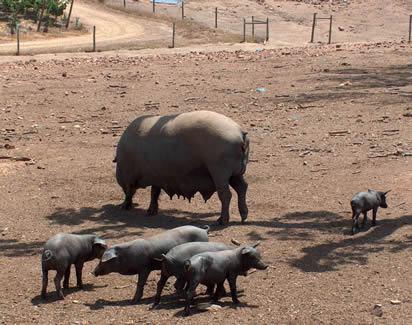 Yesterday
I introduced you to the black pigs of the Alentejo. I thought you
might also like to meet the highly cute (I think so) baby black pigs I
met at new superstar estate Malhadinha Nova. Last night finished off
the bottle of Monte de Peceguina 2004, the second wine from this
estate, which retails around 10 Euros in Portugal. It's wonderful
stuff, packed full of pure red fruits. Yesterday
I introduced you to the black pigs of the Alentejo. I thought you
might also like to meet the highly cute (I think so) baby black pigs I
met at new superstar estate Malhadinha Nova. Last night finished off
the bottle of Monte de Peceguina 2004, the second wine from this
estate, which retails around 10 Euros in Portugal. It's wonderful
stuff, packed full of pure red fruits.
Today
is looking like it's going to be a scorcher. Time to fire up the
barbie, but first I've got to survive the school fete, and nip off to
the allotment to spray the vines with sulphur, to combat the risk of
mildew.
Friday
17th June
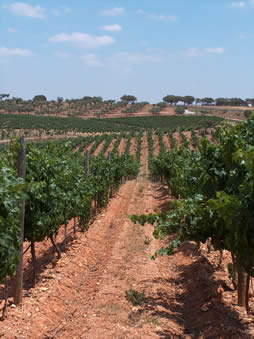 Just
back from the Alentejo. For those unfamiliar with this, it's a big
Portuguese wine region inland and down from Lisbon. Portugal has two
leading, quite different wine regions - the Alentejo is one, the other
is the Douro - both of which are a hotbed of innovation and expansion,
with new producers popping up all over the place. I visited quite a
range of properties (Jo„o Costa of ICEP was kind enough to take
account of all my requests, made easier by the fact that the only
other journalist on the trip was Julie Arkell - she was good company,
and one of the few people who could put up with my endless questions
and photo-stops), including Mouch„o, Cortes de Cima, Mouro and
Cartuxa. Just
back from the Alentejo. For those unfamiliar with this, it's a big
Portuguese wine region inland and down from Lisbon. Portugal has two
leading, quite different wine regions - the Alentejo is one, the other
is the Douro - both of which are a hotbed of innovation and expansion,
with new producers popping up all over the place. I visited quite a
range of properties (Jo„o Costa of ICEP was kind enough to take
account of all my requests, made easier by the fact that the only
other journalist on the trip was Julie Arkell - she was good company,
and one of the few people who could put up with my endless questions
and photo-stops), including Mouch„o, Cortes de Cima, Mouro and
Cartuxa.
I
was very impressed by the overall standard, but the most exciting find
for me was a new estate by the name of Malhadinha Nova. This is a name
to watch out for. With a no holds barred approach to quality and some
fantastic vineyards (left), they are already one of the very
best producers in the Alentejo. As well as growing vines, they keep
pigs and cattle. These 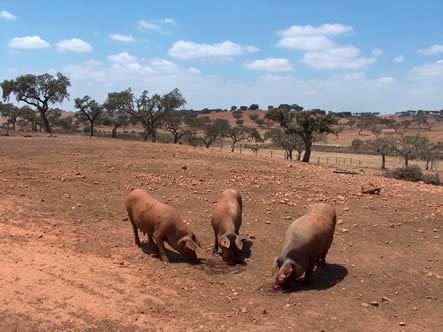 are
no ordinary pigs - they are the pata negra pigs (right) that by
law have to feed predominantly on acorns, and 1 hectare of oak trees
is needed for each single animal. We had a memorable lunch here,
including some of the wonderful pata negra ham. The second wine, Monte
da Peceguina, is superb, and wonderful value, but I suspect most of
the fuss will be made of the first wine Malhadina. There are two
whites, in addition to these reds, and both are also fantastic -
unusual for the Alentejo, which is really a red wine
region. are
no ordinary pigs - they are the pata negra pigs (right) that by
law have to feed predominantly on acorns, and 1 hectare of oak trees
is needed for each single animal. We had a memorable lunch here,
including some of the wonderful pata negra ham. The second wine, Monte
da Peceguina, is superb, and wonderful value, but I suspect most of
the fuss will be made of the first wine Malhadina. There are two
whites, in addition to these reds, and both are also fantastic -
unusual for the Alentejo, which is really a red wine
region.
Previous entries
Back to top
|